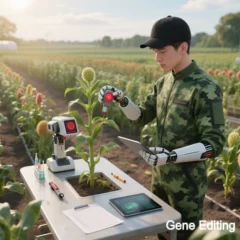CRISPR (Clustered Regularly Interspaced Short Palindromic Repeats) is a revolutionary gene-editing technology derived from a natural bacterial immune system.
Key points:
Uses a guide RNA to direct the Cas9 protein to cut specific DNA sequences.
Allows precise insertion, deletion, or modification of genes.
Applications: curing genetic diseases, improving crops, biomedical research.
Nobel Prize in Chemistry (2020) awarded to Doudna & Charpentier for its discovery.
It’s faster, cheaper, and more accurate than older gene-editing methods.

GenRNA.com
Applications and Innovations of Biosensors in Drug Screening Biosensors have revolutionized drug screening with their high sensitivity, real-time monitoring, and target-specific recognition. Below, we categorize key examples by technological principles and application scenarios, highlighting breakth…

SynBio
The Pivotal Role of High-Precision Sensors in Synthetic Biology High-precision sensors are central to achieving dynamic control, real-time monitoring, and precision design in synthetic biology, with applications spanning fundamental research to industrial deployment. Below, we dissect their multidim…

synbiok.com
Core Challenges in Synthetic Biology Kinetics: A Deep Dive I. Foundational Challenges in Model Construction Parameterization Challenges & Data Noise Kinetic models (e.g., ODEs, FBA) for synthetic biosystems rely heavily on experimental parameters such as enzymatic reaction rates (kcatkcat) and …

synbiok.com
Synthetic Biology Kinetics: Theoretical Foundations for Rational Design of Biosystems Synthetic biology kinetics bridges quantitative modeling and biological system engineering, providing a mathematical framework to predict and control the dynamic behavior of engineered biological systems. This disc…

synbiog.com
Synthetic Biology: Key Directions in Gene Manipulation I. Foundational Gene-Editing Technologies DNA Synthesis & Assembly Chemical Synthesis: Solid-phase phosphodiester bond-based synthesis produces single-stranded DNA up to 200–300 bp, enabling full gene synthesis (e.g., artificial yeast chromo…

synbioe.com
Synaptophysin: Biological Expression and Cutting-Edge Advances I. Core Concepts of Synaptophysin Biosynthesis Definition Synaptophysin (SYP), a 38 kDa transmembrane glycoprotein belonging to the tetraspanin family, is predominantly localized on presynaptic vesicle membranes in neurons (constituting …

PCR
Comprehensive Applications of Polymerase Chain Reaction (PCR) Across Diverse Fields I. Gene Cloning: Precision Amplification and Vector Construction Principles and Procedures PCR enables specific amplification of target DNA fragments through primer design, providing high-purity templates for gene cl…

Gene Editing
In Vivo vs. Ex Vivo Gene Editing Therapies: Key Differences and Future Prospects (as of May 2025) Core Definitions and Technical Pathways Aspect Ex Vivo Gene Editing In Vivo Gene Editing Workflow Cells extracted, edited in vitro, and reinfused Editing tools delivered directly to target tissues/cells…

Gene Editing
Gene Editing in Cancer Therapy and Antiviral Research: Recent Advances and Applications (as of May 2025) I. Cancer Therapy: Revolutionizing Treatment Paradigms Gene editing technologies (e.g., CRISPR-Cas9, Prime Editing, Base Editing) are reshaping cancer treatment by targeting oncogenes, modulating…

Gene Sequencing
Gene Sequencing: Decoding the Blueprint of Life What is Gene Sequencing? Gene sequencing is the process of determining the precise order of nucleotide bases—adenine (A), thymine (T), cytosine (C), and guanine (G)—within a DNA molecule. This sequence dictates genetic information and functionality, en…










